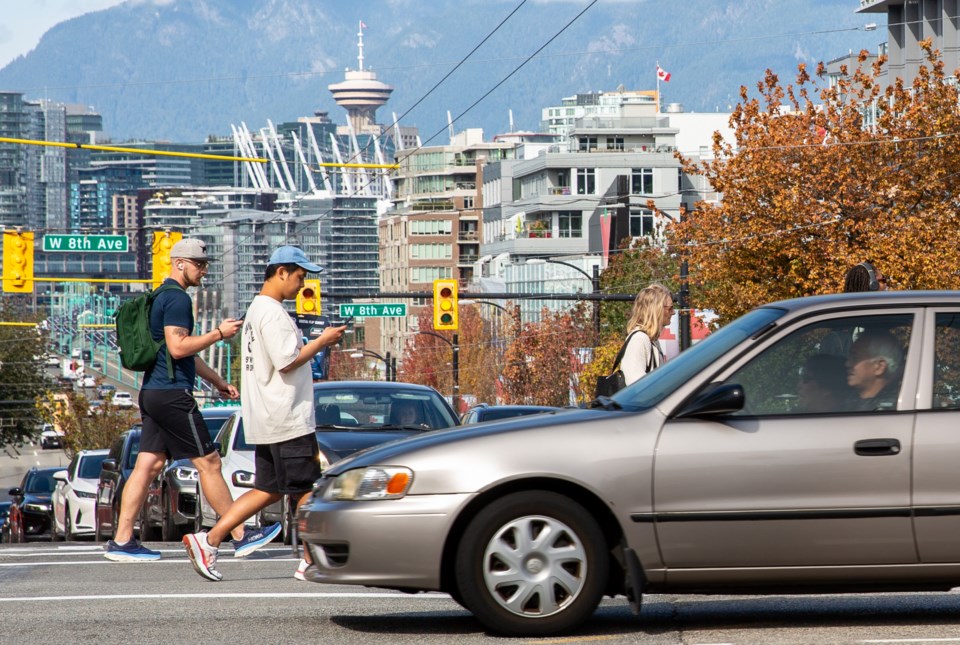Does texting on a phone while walking in Vancouver make a person less safe around cars?
The answer, as Gabriel Lanzaro acknowledged, is obvious: of course it does.
But as Lanzaro pointed out, there isn’t a lot of research available on the topic, particularly in Vancouver, a city that continues to widen sidewalks, upgrade crosswalks and create public plazas adjacent to main roads.
“A lot has been going on in terms of how we can prevent drivers from texting and the dangerous consequences of texting while driving, but little has been done regarding distracted pedestrians and their consequences in traffic,” said Lanzaro, a graduate student in the department of civil engineering at the University of B.C. (UBC).
As cities migrate towards more sustainable transportation, Lanzaro said the question that inspired his research into distracted pedestrians was this: Are cities designing roads that are safer and accounting for the fact that pedestrians can be distracted as well?
Lanzaro was one of three authors of a study published last week in Accident Analysis and Prevention that focused on pedestrians using two Vancouver intersections: Granville and Smithe, and Pacific and Thurlow.
His co-authors were Tarek Sayed, a UBC professor, and civil engineering graduate student, Tala Alsharif.
'Computer vision system'
The trio used a “computer vision system” developed at UBC and artificial intelligence simulation models to analyze video traffic data from the intersections on June 19, 2018 and Sept. 25, 2018.
The study found 321 distracted pedestrians were involved in what Lanzaro described as “near misses” with vehicles when crossing the intersection. The large majority were texting, while others were talking on a phone, reading from a phone or listening to music.
“One of the findings of our study is that when the pedestrian is distracted, the severity of these interactions — how close the pedestrians are with vehicles — increases by 46 per cent,” he said.
“This erratic behaviour, where they deviate from their paths and potentially approach vehicles more suddenly, could result in severe incidents. If I were to highlight something from this study, it’s that texting is a big ‘no’ under these circumstances.”
Another observation was that pedestrians who were texting also walked slower and took more time to cross a street — a finding that could be useful to the city’s engineering department in increasing the signal cycle to incorporate more distracted pedestrians, Lanzaro said.
Penalties for distracted pedestrians
Imposing penalties on distracted pedestrians is not something Lanzaro advocates, acknowledging the impractical task of enforcement when considering the number of people who use phones while walking.
Rather, he wants more of an educational approach to keep pedestrians safe such as installing audio messages in intersections that warn of the dangers of being distracted by a phone while near vehicles.
“Instead of penalties, we can recognize that pedestrian distraction may exist, and we can potentially change the signal cycles…or maybe use sensor-based systems to let people know: ‘Please keep your phone down to cross the road,’” he said.
Lanzaro suggested the research could also be used to assist in the design of autonomous vehicles, or self-driving cars, which are not yet legal for people to operate, although they are being tested in Canada.
“They have to anticipate pedestrians’ behaviours, and as we have seen in this study, that behaviour is considerably different, and we were able to quantify how different it is,” he said. “So we can design the autonomous vehicles to have more proper responses for distracted pedestrians.”
Not surprisingly, the study found non-distracted pedestrians made safer choices when interacting with vehicles. They maintained greater distances from vehicles, yielded more frequently to oncoming traffic and adjusted their speed when necessary.






